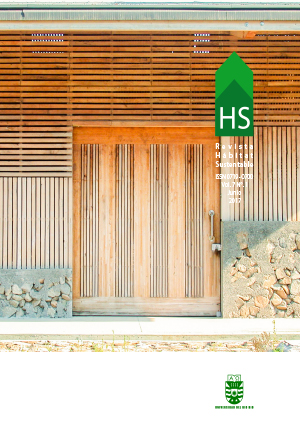A thermal evaluation of the ISOBLOCK material in the warm, dry climate of ciudad Juárez, Mexico.
DOI:
https://doi.org/10.22320/07190700.2017.07.02.02Keywords:
thermal mass, Isoblock, thermal resistanceAbstract
In order for dwellings to improve their thermal behavior and reduce energy consumption due to the excessive use of conventional air heating and cooling systems, the Mexican Energy Efficiency Standards establish a minimum thermal resistance factor ("R") according to each climatic region of the country. This article presents the conclusions of thermal research on the material known as Isoblock, which: consists of a concrete block with insulation inside and satisfactorily meets the "R" factor required by the regulations. The study seeks to demonstrate the necessity of taking the thermal mass of materials into consideration within the thermal parameters in the aforementioned regulations. From that approach, the methodology consisted in comparing the Isoblock with a conventional concrete block in two modules with the same characteristics during the extreme seasons in Ciudad Juárez, Chihuahua. Lastly, a simulation was carried out using Design Builder V4.5 software and the results were correlated for validation. With these results, the Isoblock module was simulated with a greater amount of thermal mass without varying its thickness, to measure its impact on the interior temperature. The results obtained demonstrate that a material with the same "R" factor can produce more comfortable indoor air temperatures in extreme seasons.
Downloads
References
CONAGUA, Comisión Nacional del Agua. Servicio Meteorológico Nacional, Normales Climatológicas por Estación. [en línea] [Consultado 25 junio 2016]. Disponible en: www.smn.cna.gob.mx
ANSI/ASHRAE Standard 55-2010. Thermal Environmental Conditions for Human Occupancy. American Society of Heating Refrigeration and Air-conditioning Engineers, pp. 11-12.
Informe Bruntland. Documentación de las Naciones Unidas (s.f.). [en línea] [Consultado 25 junio 2016]. Disponible en: http://www.un.org/depts/dhl/spanish/resguids/specenvsp.htm
CONAVI. (2010). Soluciones verdes para el sector vivienda. México: CONAVI. p.17.
Fundación para la implementación, diseño, evaluación y análisis de política públicas A.C. (2013). Estrategia Nacional para la Vivienda Sustentable. México: Fundación IDEA A.C. p.28.
Vallejo, Víctor. Las diversas certificaciones aplicables a los edificios sustentables en México. Multidisciplinar Núm. 18, may-ago. 2014, pp 29-58. [en línea] [Consultado 25 agosto 2017]. Disponible en: http://www. Acatlan.unam.mx/file_download/2081/multi-2014-05-02.pdf
Organismo Nacional de Normalización y Certificación de la Construcción y Edificación S.C. [en línea] [Consultado 20 agosto 2017]. Disponible en:
http://www.onncce.org.mx/index.php/es/.
Morales, N. Normas Oficiales Mexicanas de Eficiencia Energética Aplicables a la Envolvente de los Edificios. [en línea][Consultado 20 agosto 2017]. Disponible en: https://www.gob.mx/cms/uploads/attachment/file/84515/Norma_8.pdf
Grupo Cementos de Chihuahua. Isoblock GCC, block térmico de concreto. [en línea] [Consultado 20 agosto 2017]. Disponible en: http://www.gcc.com/wp-content/uploads/2016/08/ISOBLOCK-Folleto-0817_digital-final.pdf
Downloads
Published
How to Cite
Issue
Section
License
The content of articles which are published in each edition of Habitat Sustentable, is the exclusive responsibility of the author(s) and does not necessarily represent the thinking or compromise the opinion of University of the Bio-Bio.
The author(s) conserve their copyright and guarantee to the journal, the right of first publication of their work. This will simultaneously be subject to the Creative Commons Recognition License CC BY-SA, which allows others to share-copy, transform or create new materials from this work for non-commercial purposes, as long as they recognize authorship and the first publication in this journal, and its new creations are under a license with the same terms.











 Scientific Information Program/Concurso Fondos de Publicación de Revistas Científicas 2018/ Proyecto Mejoramiento de Visibilidad de Revistas UBB (Código:FP180007).
Scientific Information Program/Concurso Fondos de Publicación de Revistas Científicas 2018/ Proyecto Mejoramiento de Visibilidad de Revistas UBB (Código:FP180007).





